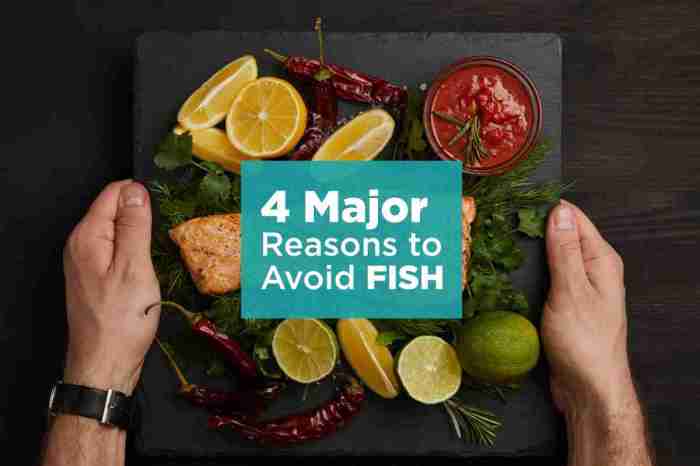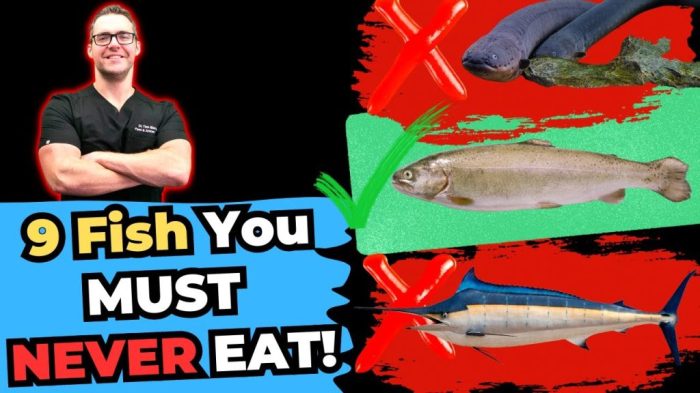Embark on a culinary adventure with the no fish diet, a dietary approach that excludes all types of fish and seafood. Discover its potential health benefits, explore its variations, and delve into the intricacies of adopting this lifestyle. Join us as we navigate the world of no fish diets, empowering you with informed choices.
From understanding the rationale behind eliminating fish to exploring the diverse options available, this comprehensive guide provides a roadmap for those seeking to adopt a no fish diet. Whether your motivation stems from ethical concerns, environmental sustainability, or health reasons, this exploration will equip you with the knowledge to make informed decisions.
Introduction
A ‘no fish diet’ is a dietary approach that excludes all types of fish and seafood from consumption. This includes both saltwater and freshwater fish, as well as shellfish, crustaceans, and mollusks.
There are several potential benefits associated with adopting a no fish diet. These include:
- Reduced risk of cardiovascular disease: Fish is often considered a healthy food choice due to its high omega-3 fatty acid content. However, some studies have suggested that certain types of fish may contain high levels of environmental contaminants, such as mercury, which can increase the risk of cardiovascular disease.
Adopting a vegetarian diet can be a healthy and sustainable choice, but it’s essential to ensure you’re getting the right nutrients. A well-balanced vegetarian diet should include plenty of fruits, vegetables, and whole grains. Legumes, nuts, and seeds are also important sources of protein and fiber.
By following a good vegetarian diet , you can enjoy a nutritious and flavorful way of eating that promotes overall well-being.
- Lowered risk of certain types of cancer: Some research indicates that a no fish diet may be associated with a reduced risk of certain types of cancer, such as prostate cancer and breast cancer.
- Improved brain health: Fish is a good source of omega-3 fatty acids, which are essential for brain health. However, some studies have suggested that a no fish diet may not provide sufficient omega-3 fatty acids, which could potentially affect brain function.
- Reduced exposure to environmental contaminants: Fish can accumulate environmental contaminants, such as mercury and PCBs, which can be harmful to human health. A no fish diet can help reduce exposure to these contaminants.
- Ethical concerns: Some individuals choose to adopt a no fish diet for ethical reasons, as they believe that fishing practices can be harmful to marine ecosystems and animal welfare.
Types of ‘No Fish’ Diets
No fish diets, also known as pescatarian diets, encompass a wide range of dietary approaches that exclude fish and seafood while allowing other animal products, such as meat, poultry, and dairy. These diets vary in their level of restrictiveness and can be tailored to individual preferences and health needs.
The most common types of no fish diets include:
Lacto-ovo pescatarian
This is the most flexible type of no fish diet, allowing for the consumption of dairy products and eggs in addition to meat and poultry. It is a relatively easy diet to follow and provides a wide range of nutrient-rich foods.
Lacto pescatarian
This diet excludes eggs but allows for the consumption of dairy products. It is a good option for individuals who are allergic to eggs or who have ethical concerns about egg production.
Ovo pescatarian
This diet excludes dairy products but allows for the consumption of eggs. It is a good option for individuals who are lactose intolerant or who have ethical concerns about dairy production.
If you’re considering adopting a vegetarian lifestyle, you’ll want to make sure you’re getting all the nutrients your body needs. A good vegetarian diet includes a variety of fruits, vegetables, whole grains, and legumes. It’s also important to include a source of vitamin B12, which is not found in plant foods.
Vegan pescatarian
This is the most restrictive type of no fish diet, excluding all animal products, including fish, seafood, meat, poultry, dairy, and eggs. It is a challenging diet to follow but can provide a number of health benefits.
Benefits of a ‘No Fish’ Diet
Adopting a ‘no fish’ diet can offer several health benefits, particularly for individuals concerned about environmental sustainability or those with specific dietary restrictions.
Scientific evidence suggests that eliminating fish consumption can improve overall health in various ways:
Reduced Exposure to Contaminants
- Fish can accumulate heavy metals, such as mercury and lead, from their environment.
- Consuming fish regularly can lead to increased levels of these contaminants in the body, potentially causing adverse health effects.
- A ‘no fish’ diet can significantly reduce exposure to these harmful substances, promoting overall well-being.
Lower Risk of Cardiovascular Disease, No fish diet
- Some fish species contain high levels of saturated fat, which can contribute to elevated cholesterol levels and increase the risk of cardiovascular disease.
- Eliminating fish consumption can reduce saturated fat intake, potentially lowering the risk of heart disease and stroke.
Improved Cognitive Function
- Fish is often touted as a good source of omega-3 fatty acids, which are essential for brain health.
- However, studies have shown that plant-based sources of omega-3s, such as flaxseeds and walnuts, can provide similar benefits without the potential risks associated with fish consumption.
Sample Meal Plan

A ‘no fish’ diet excludes all types of fish and seafood, including shellfish. This meal plan provides a variety of nutrient-rich options to ensure a balanced and satisfying diet.
Breakfast
- Oatmeal with berries, nuts, and seeds
- Yogurt with fruit and granola
- Whole-wheat toast with avocado and eggs
- Smoothie made with fruits, vegetables, and plant-based milk
Lunch
- Salad with grilled chicken, vegetables, and quinoa
- Sandwich on whole-wheat bread with hummus, vegetables, and cheese
- Soup and salad
- Leftovers from dinner
Dinner
- Grilled chicken with roasted vegetables
- Lentil soup with whole-wheat bread
- Pasta with marinara sauce and vegetables
- Stir-fry with tofu, vegetables, and brown rice
Snacks
- Fruits and vegetables
- Nuts and seeds
- Yogurt
- Hummus with whole-wheat crackers
Tips for Success
Adopting a ‘no fish’ diet requires planning and commitment. Here are some tips to help you succeed:
Plan your meals:Prepare meals ahead of time to avoid unhealthy choices when short on time. Incorporate a variety of plant-based foods to ensure nutritional adequacy.
Overcoming Challenges
- Cravings:Identify triggers that lead to cravings and find healthy alternatives. Consider carrying plant-based snacks like nuts or fruit.
- Dining out:Research restaurants in advance to find vegan or vegetarian options. If necessary, bring your own plant-based food.
- Social events:Inform hosts of your dietary restrictions and offer to bring a dish to share. Be prepared to politely decline dishes containing fish.
- Supplements:Consult a healthcare professional about supplementation, especially for nutrients like omega-3 fatty acids and vitamin B12, which may be lower in a ‘no fish’ diet.
Conclusion

A ‘no fish’ diet involves abstaining from consuming any type of fish or seafood. This dietary approach offers various potential benefits, including reduced exposure to contaminants, improved heart health, and a lower risk of certain health conditions.
However, it’s important to consider the potential drawbacks, such as ensuring adequate intake of essential nutrients like omega-3 fatty acids and vitamin D. Consulting with a healthcare professional or registered dietitian is crucial before making significant dietary changes.
Summary

The no fish diet presents a unique opportunity to explore alternative sources of nutrition while potentially reaping health benefits. While adopting this dietary approach requires careful planning and attention to nutrient intake, the potential rewards can be substantial. By embracing a plant-based or alternative seafood-based diet, individuals can contribute to their well-being and make a positive impact on the environment.
Remember to consult with a healthcare professional before making any significant dietary changes to ensure a safe and balanced approach.
FAQ Overview: No Fish Diet
Can a no fish diet provide adequate protein?
Yes, a well-planned no fish diet can provide sufficient protein through plant-based sources such as legumes, beans, lentils, tofu, tempeh, nuts, and seeds.
Are there any potential risks associated with a no fish diet?
A no fish diet may increase the risk of certain nutrient deficiencies, such as vitamin B12, omega-3 fatty acids, and iodine. Supplementation or consuming fortified foods can help mitigate these risks.
Is a no fish diet suitable for everyone?
While a no fish diet can be beneficial for many, it may not be appropriate for everyone. Individuals with certain health conditions, pregnant or breastfeeding women, and children should consult with a healthcare professional before adopting this dietary approach.